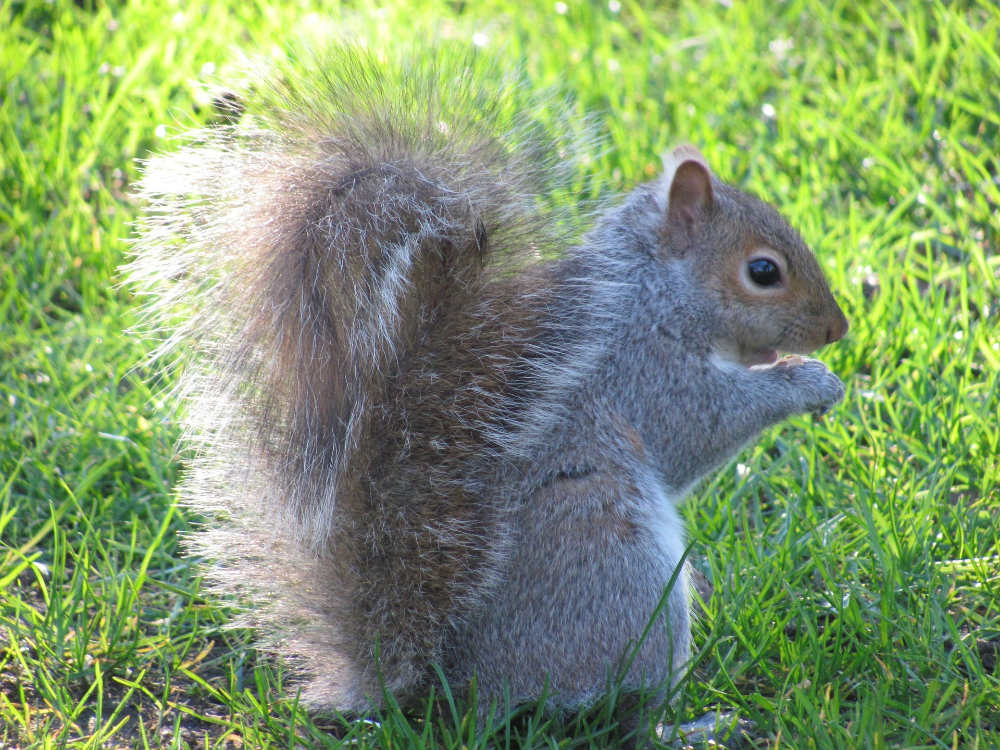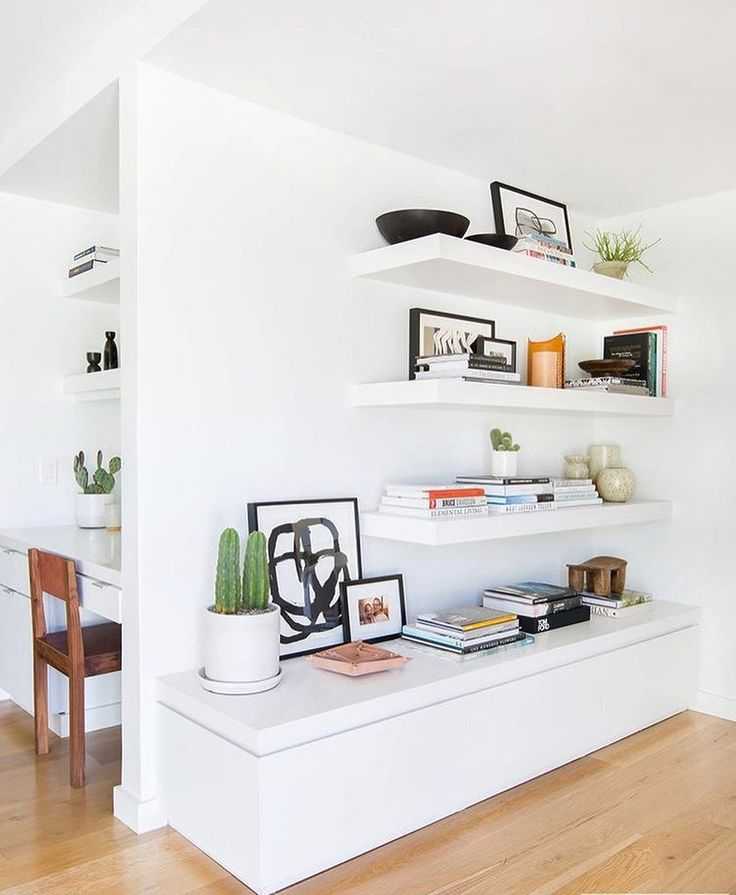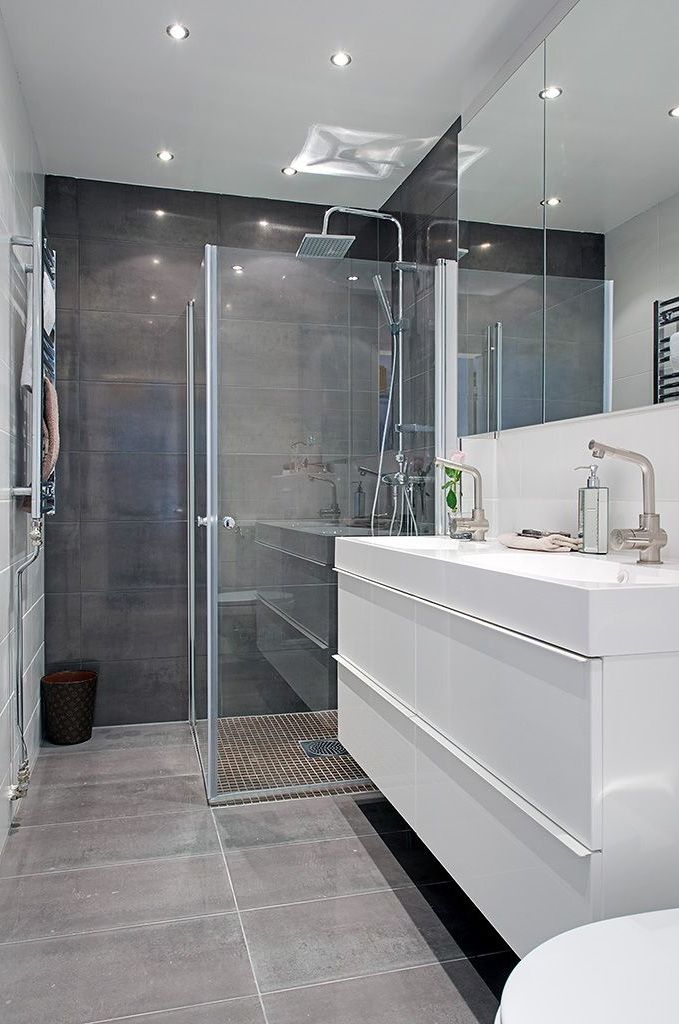Planting nasturtium from seed
How to Grow Nasturtiums from Seed
More Articles
Find more garden information
Other Article Categories
Choose CategoryVegetable GardeningFlower GardeningSoil and CompostBackyard HabitatPests and DiseasesIndoor GardeningLandscape and LawnRecipesDIYAdvice Flower Gardening How to Grow Nasturtiums from Seed
By David Grist
Not only are nasturtiums beautiful, they are edible.What are some easy annuals to start from seed?"
When I get that question, I always include nasturtiums on my list of suggestions. The seeds are fairly large and they can be planted right in the garden. To get an earlier start, you can plant indoors.
Start outdoors in the garden:
Also known as "direct sowing," this technique is sometimes used instead of planting indoors. It's a good choice for seeds that don't require a lot of coddling, or seedlings that suffer from transplant shock.
In the case of nasturtiums, it's convenient because you can plant them right where you want them to grow and never have to transplant. Just wait till the danger of frost has passed. Not sure of the date in your area? Use a Zip Code look-up. In hot climates, choose a site that's shaded from hot afternoon sun. Nasturtium seeds are usually planted an inch deep and about 10 inches apart. You can plant them closer together and then move them once the seedlings have several sets of leaves. Always check the seed packet for specifics. As for soil, nasturtiums are not picky and will thrive even in poor soil as long as they are watered regularly.
Direct sowing is sometimes risky because you might pull up the seedlings when you're weeding the bed. To prevent accidental weeding, mark the planting site with a label. Because of the distinctive foliage, nasturtium seedlings are easy to spot.
Start indoors in pots:
If you want to start with larger plants — and get earlier blooms — start the seeds indoors.
Because they are large seeds, I like to start with a relative large, 2-3/4" or 3" seed starting pot. Put two seeds (1" deep) in each pot and grow them under lights or in a bright location, such as a south-facing window. It takes about 10 to 12 days for nasturtiums to germinate. When the seedlings have a few sets of leaves, pinch out the weaker seedling, leaving one per pot. Why plant two seedlings when you're going to pluck out the weaker one? It's mostly for insurance, in case one of the seeds fails to germinate. If you're feeling confident about your seed source — or thrifty — go with smaller pots and plant one seed in each.
When the weather moderates and nighttime temperatures are in the 50s, I harden off the seedlings. This involves moving them outdoors during the day and bringing them in at night. After a couple days, I plant them in the garden. To reduce transplant shock, I tear off the top edge of the Cowpot and plant the seedling — pot and all. It's important that the top edge of the pot is buried to prevent soil moisture from wicking away from the seedling.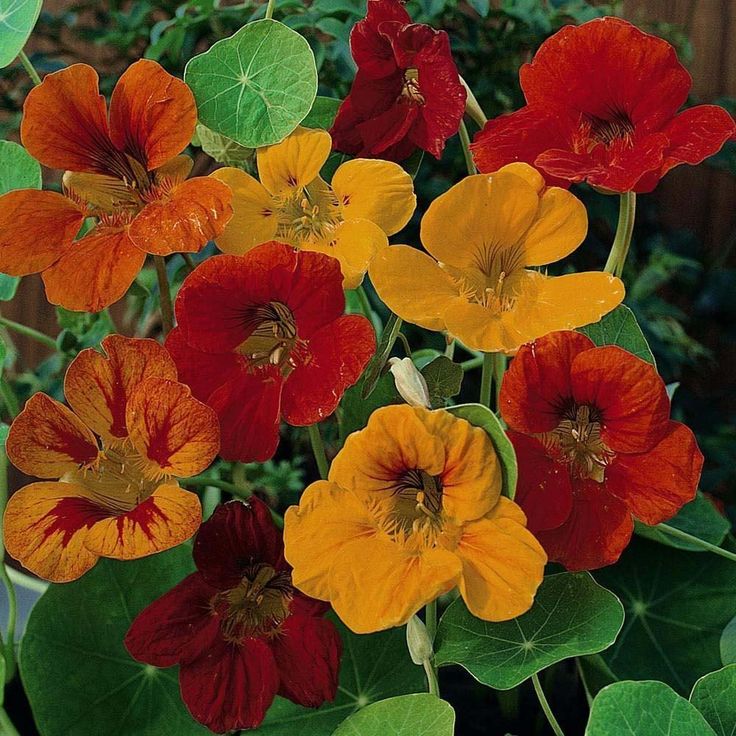
Growing On
Nasturtiums are fairly carefree, but it's important to keep them watered during dry periods. They do well in containers and windowboxes. Let the soil get dry between waterings, but don't let it dry out. Feed them regularly with liquid fertilizer to ensure plenty of blooms through the summer.
Nasturtiums have edible flowers that taste peppery, like watercress. All colors and varieties are tasty in salads or as garnishes. Leaves can be eaten, too.
Buy nasturtium seeds
Related articles
- How Plants Climb
- Annuals to Grow from Seed
- Growing Sweet Peas
- How to Plant a Cutting Garden
Last updated: 01/25/2021
Share this Article:
Related Articles
-
Flowers You Can Eat
-
Growing Annual Flowers from Seed
-
How to Select the Right Seed-Starting System
Get the Dirt
Stay up to date on new articles and advice.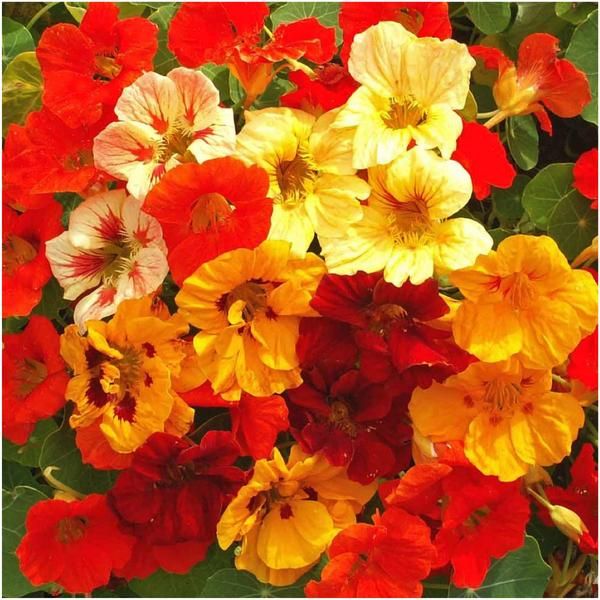 Please fill out the information below.
Please fill out the information below.
Share this Article:
Related Articles
-
Flowers You Can Eat
-
Growing Annual Flowers from Seed
-
How to Select the Right Seed-Starting System
How To Start Nasturtium From Seeds Indoors
If you’re looking for a beautiful addition to your garden, then you may want to know how to grow nasturtium. Nasturtiums are beautiful flowers that work well in many gardens.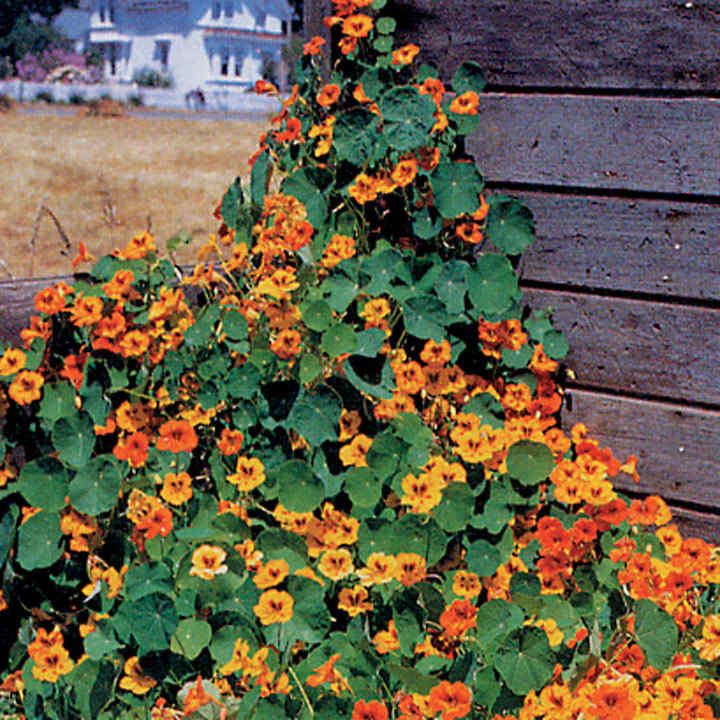 They’re aesthetically pleasing, attractive to pollinators, and even edible! If the weather isn’t warm enough to plant your nasturtium, then you should consider starting them as seeds indoors. Not sure how to start? Don’t worry, we’ll break down everything you need to know, including when to start your seeds, how to care for them, and when to move your nasturtium outdoors.
They’re aesthetically pleasing, attractive to pollinators, and even edible! If the weather isn’t warm enough to plant your nasturtium, then you should consider starting them as seeds indoors. Not sure how to start? Don’t worry, we’ll break down everything you need to know, including when to start your seeds, how to care for them, and when to move your nasturtium outdoors.
Contents
- Why and when you should start nasturtium indoors
- How to start your nasturtium seeds
- When and how to transplant your nasturtium
Why and when you should start nasturtium indoors
Nasturtiums take between four and six weeks to fully mature, and they can’t be started outdoors until after the last frost of the season has passed. Starting your seeds indoors allows you to begin the growing process earlier in the year, since you’re able to protect them from the cold. This means that, although the maturation process still takes four to six weeks, you can have bright, lovely flowers earlier in the year.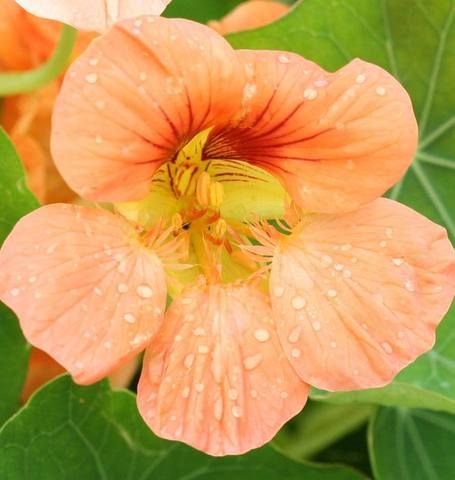
However, those beautiful mature plants still need to be planted after the frosts pass, so you’ll need to time your start date based on that. Start your seeds four to six weeks before the last frost date, so your nasturtiums will be ready to transplant once the weather warms. Keep an eye on your local weather and the projected last frost date, and, when in doubt, err on the side of caution.
How to start your nasturtium seeds
You can start your nasturtium in regular potting soil, or use some soil from your garden. If you take soil from your garden, let it sit indoors in a warm place for a day or two before planting, to avoid shocking the seeds with frozen soil. Nasturtium seeds are larger than many other common garden flowers, so they need more space from the outset. Start them in a pot that is two or three inches across and plant the seeds half an inch to an inch down.
If you want to save yourself some time and trouble later on, you can plant your nasturtium in a biodegradable pot.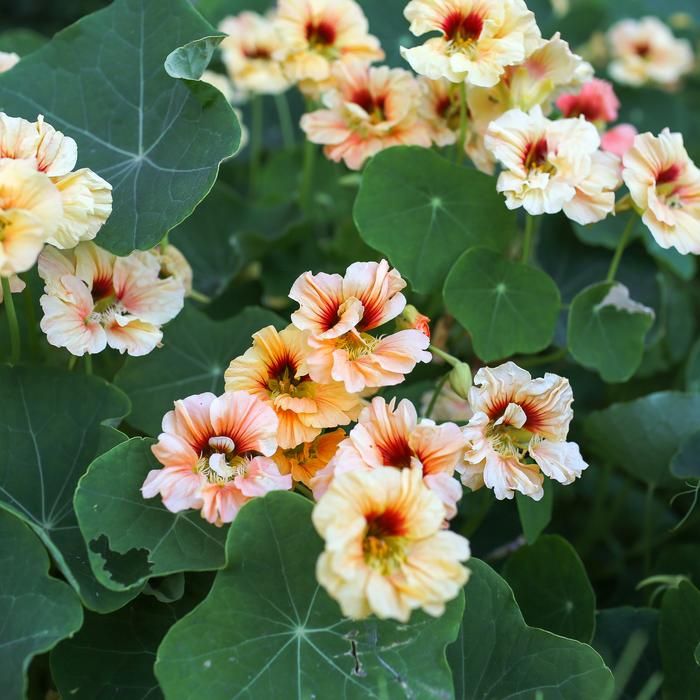 Transplanting nasturtium can be stressful for some, but biodegradable flower pots make this a nonissue. Once your pots have been picked and your seeds are sown, the only things you need to worry about are light, warmth, and water. Light and warmth go hand in hand, and nasturtiums need plenty of both. Keep your pots in your sunniest window. If you live in an area with cloudy winters, you may need to invest in a grow light.
Transplanting nasturtium can be stressful for some, but biodegradable flower pots make this a nonissue. Once your pots have been picked and your seeds are sown, the only things you need to worry about are light, warmth, and water. Light and warmth go hand in hand, and nasturtiums need plenty of both. Keep your pots in your sunniest window. If you live in an area with cloudy winters, you may need to invest in a grow light.
Nasturtium seeds and seedlings need consistent moisture, but you still need to be careful to avoid overwatering them. Be sure there’s a drainage hole in the bottom of the pot, and check that there isn’t a buildup of water in the lower levels of soil in the pot. This can become an issue when pots are larger than the plant’s root system, and it can lead to root rot or fungal infections over time.
When and how to transplant your nasturtium
Nasturtiums can be transplanted anytime after the last frost of the season, once the plant is mature. Although you can transplant seedlings, they’re more vulnerable to the elements, so any sudden late freezes or severe weather is likely to damage or kill them.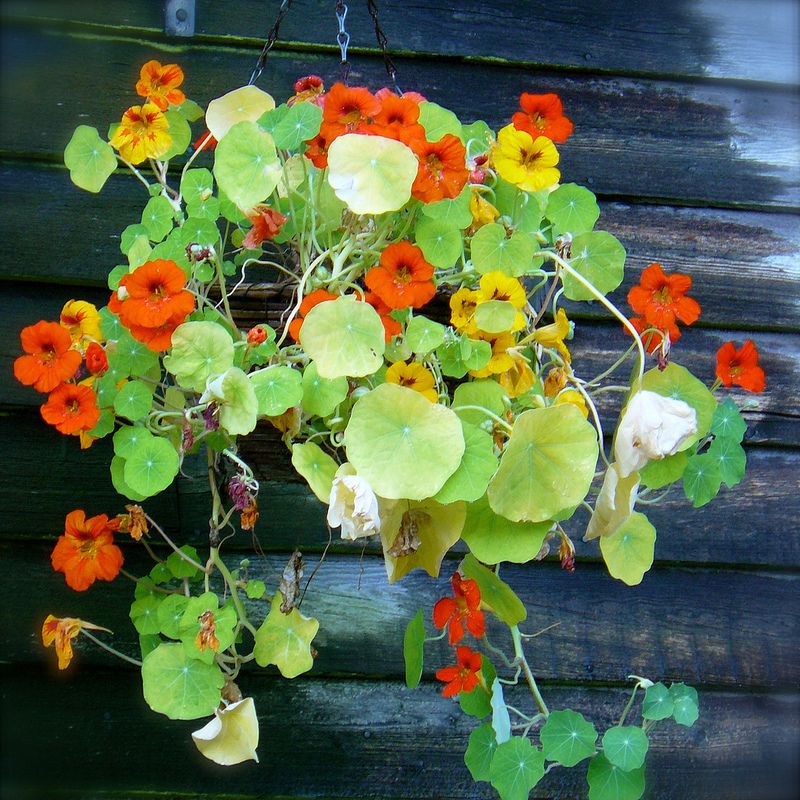
Choose a planting site that’s in full sun, with some afternoon shade if you live in a region with intense afternoon heat. Nasturtiums need fairly consistent moisture, especially at root level. Watering them once a week in mild climates, and twice a week in hot climates, tends to yield good results.
If you used a biodegradable pot, you can dig a hole in the planting location and set the pot in it. Be sure to cover the pot fully, but leave the plant exposed. In general, the hole should be at least as deep as either the pot or the roots, and twice as wide. Digging a wider hole provides extra support for the plant and loosens the surrounding soil, making it easier for the nasturtium’s roots to grow.
If you aren’t using a biodegradable pot, you’ll need to remove the nasturtium before planting it. It’s crucial that you’re gentle, as they can be easily damaged during this process if you pull too hard on the plant. First, loosen the soil, especially at the sides. If the pot is a flexible, plastic pot then you can gently squish the sides.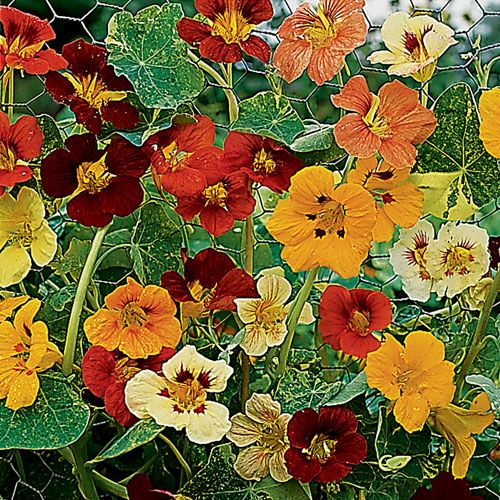 If the pot isn’t, then take a small, flat object, such as a butter knife, and slip it into the soil at the edges of the pot.
If the pot isn’t, then take a small, flat object, such as a butter knife, and slip it into the soil at the edges of the pot.
Next, gently tip the pot onto its side. The nasturtium should slide out, but it may need some coaxing. Slowly and gently pull at the base of the nasturtium to guide it out. If there’s resistance, continue to loosen the soil and try again.
Whether you want to grow nasturtium as part of a beautiful butterfly garden or to use in delicious salads, starting your seeds indoors will get you to where you want to go faster. Enjoy these easy-to-grow flowers! They’re low maintenance enough, you could even start several at once. Just remember to give them plenty of light and water, and you’ll be seeing results in no time.
Editors' Recommendations
- 7 beautiful, fall-blooming perennials to add to your garden
- The colors of fall flowers can be striking: 10 flowers that’ll have your garden bursting with fall colors
- Here are the best flowers and vegetables to plant in October
- The best vegetables to plant in October
- 6 gorgeous mums to add color to your autumn garden
planting and care in the open field, photo, properties
Author: Elena N. https://floristics.info/en/index.php?option=com_contact&view=contact&id=19 Category: Garden Plants Returned: Last editing:
https://floristics.info/en/index.php?option=com_contact&view=contact&id=19 Category: Garden Plants Returned: Last editing:
Content
- Listen to Article
- Planting and Care for Nastation
- Botanical Description
- Growing namsturus from seeds
- Semlos0002 Why is nasturtium so good? She is beautiful, useful, completely unpretentious to the conditions and does not require special care.
Today, more than twenty species and many varieties of this cute, useful and edible plant are grown in horticultural crops. From our article you will learn:
- what types and varieties of nasturtium exist;
- how to sow and grow these flowers in the garden;
- what are the medicinal properties of nasturtium and how can they be used.
Listen to article
Planting and caring for nasturtium
- Planting: sowing seeds in open ground in mid-late May or sowing seeds for seedlings in April, followed by planting seedlings in the ground in the first decade of June.
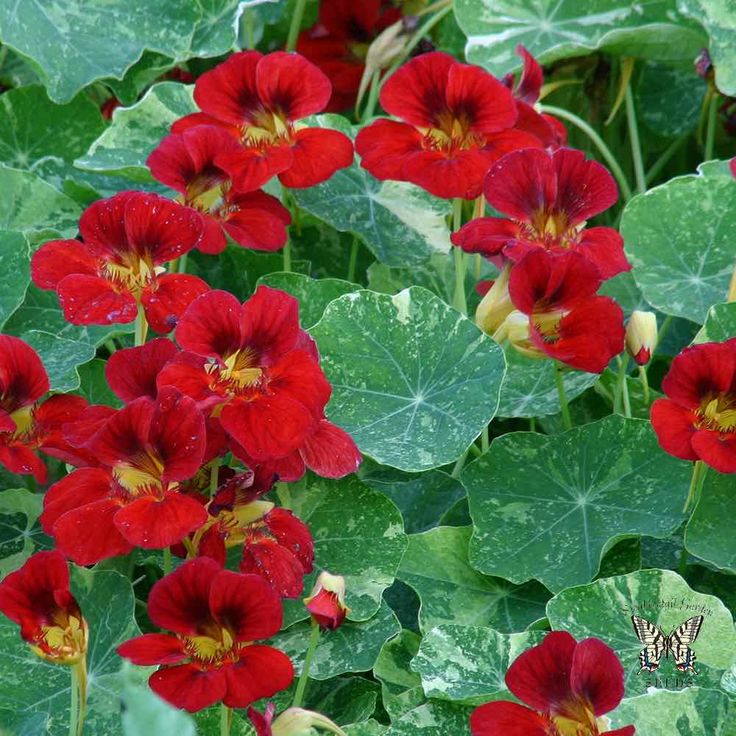
- Lighting: bright sunlight.
- Soil: light, not too fertile, well drained, slightly acidic.
- Watering: from the beginning of the growing season - regular and plentiful, during flowering - as the soil dries.
- Top dressing: once a week before flowering with potash-phosphorus fertilizers. Nitrogen is not needed. From the beginning of flowering, top dressing is stopped.
- Propagation: by seeds and cuttings.
- Pests: aphids, cabbage moths, whites, spider mites.
- Diseases: gray mold, rust, viral mosaic, black ring spot and bacterial wilt.
Read more about growing nasturtium below
Nasturtium (lat. Tropaeolum) , or capuchin , belongs to the Nasturtium family, and is a herbaceous plant, of which there are about 90 species.
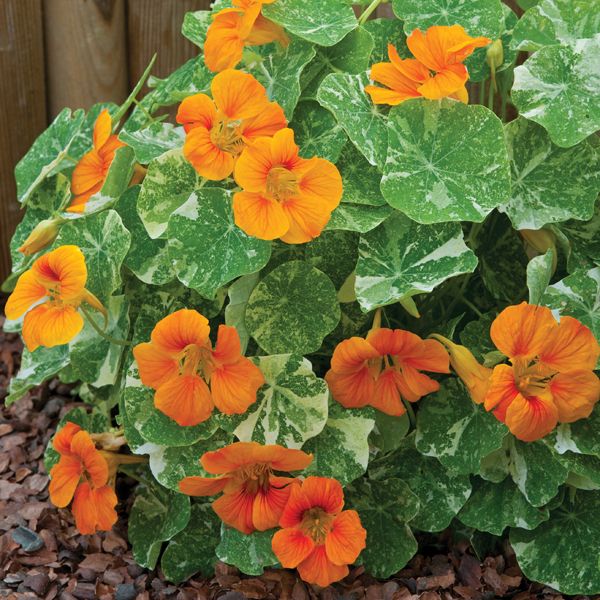 The nasturtium plant is native to South and Central America, but it also settled in our latitudes for a long time and reliably, as it is distinguished by unpretentiousness, sought-after healing properties and taste characteristics. The main thing is that the nasturtium flower with its long flowering is able to decorate any, even the most sophisticated garden. The capuchin flower brought from Holland to Russia was called so because of the shape of the flower, resembling a hood, but gradually the plant began to be called nasturtium. The official Latin name Tropaeolum was given to nasturtium by Carl Linnaeus.
The nasturtium plant is native to South and Central America, but it also settled in our latitudes for a long time and reliably, as it is distinguished by unpretentiousness, sought-after healing properties and taste characteristics. The main thing is that the nasturtium flower with its long flowering is able to decorate any, even the most sophisticated garden. The capuchin flower brought from Holland to Russia was called so because of the shape of the flower, resembling a hood, but gradually the plant began to be called nasturtium. The official Latin name Tropaeolum was given to nasturtium by Carl Linnaeus. Botanical description
Nasturtiums, both annuals and perennials, are often vines with succulent stems, and sometimes subshrubs. The leaves are most often lobed, alternate, entire, palmate or thyroid. Flowers - simple, double and semi-double - irregularly shaped, fragrant, zygomorphic, bisexual, axillary, consisting of five (sometimes more) petals, the same number of sepals, a funnel-shaped tube with nectar.
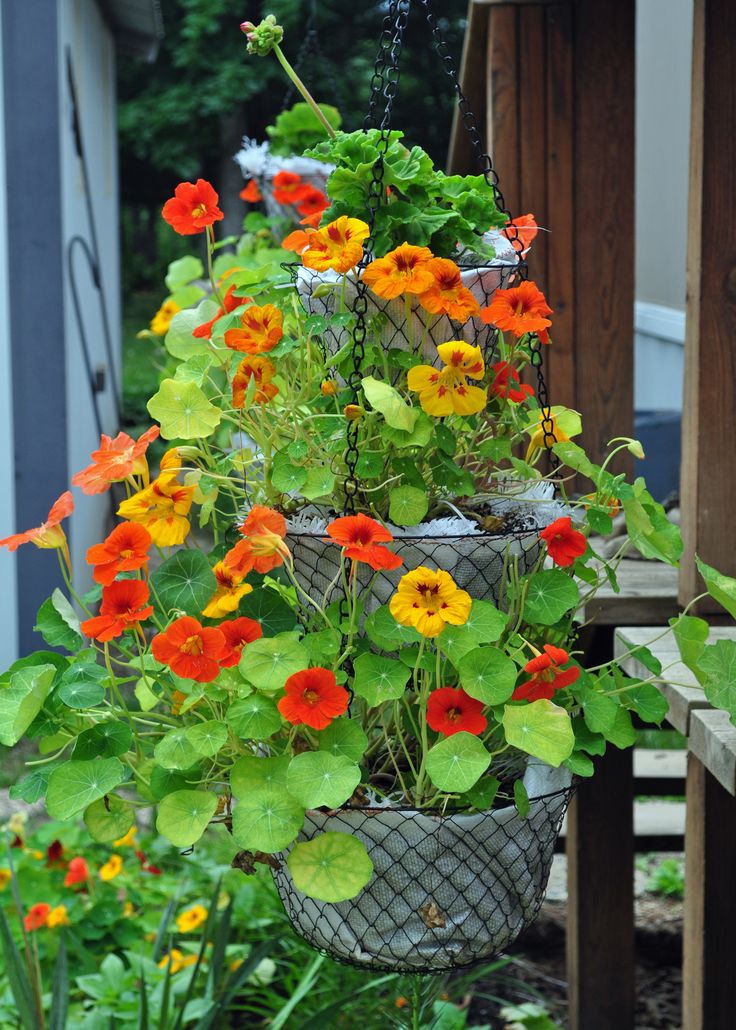
The color of the flowers is usually red or yellow. The fruit consists of three wrinkled kidney-shaped lobes, in each of which rounded kidney-shaped seeds ripen. Both flowers and stems have healing properties, and are also of interest to culinary specialists.
Growing nasturtium from seeds
Sowing seeds
Nasturtium is propagated by seed, and even a beginner can handle it. Large nasturtium seeds are sown directly into the open ground in mid or late May, when the last frosts have passed. In holes up to two centimeters deep, located at a distance of 25-30 cm from each other, nasturtium seeds are placed in a nested way - 3-4 pieces per hole. If there is a possibility of nighttime drops in temperature, cover the planted area with plastic wrap or other covering material and use only warm water for irrigation. Seedlings will appear in a week or two.
Planting and caring for kosmeya - everything you need to know
In the photo: Nasturtium seeds
Growing seedlings
Nasturtium is also grown in seedlings, which allows you to achieve earlier flowering than in the case of sowing seeds directly into the ground.
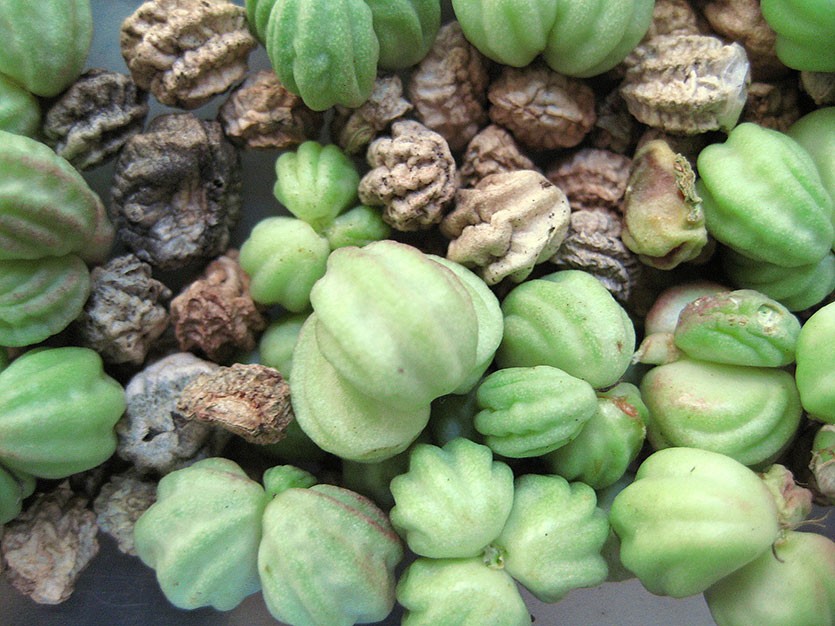 To do this, use peat cups or cups with a retractable bottom, in which in April-May seeds are sown 2-3 pieces to a depth of 2 cm. The temperature in the room with seedlings should be 20-22 ºC. Shoots will appear in a couple of weeks.
To do this, use peat cups or cups with a retractable bottom, in which in April-May seeds are sown 2-3 pieces to a depth of 2 cm. The temperature in the room with seedlings should be 20-22 ºC. Shoots will appear in a couple of weeks. - Lungwort: cultivation, properties and types
Make sure that the seedlings have enough light, because the lack of light causes them to stretch, and after landing on the site, they get sick for a long time and do not bloom.
The root system of nasturtium is weak, and the leaf surface is quite large, therefore, in order not to injure the roots, the seedlings are not swooped down and transplanted into the soil together with an earthen clod, right in a cup.
Planting nasturtium
When to plant
Nasturtium is planted in the first decade of June. Select a well-lit and wind-sheltered spot in your garden, as nasturtium flowers do not bloom as profusely in the shade as they do in good light. The soil on the site should be slightly acidic, with good drainage, light and fertile.
 On soils rich in organic matter, plants turn lush green, but they do not want to bloom, on soils that are too poor, nasturtium blooms are not so beautiful, the leaves are small, and the stems look bare. Nasturtium rots in stagnant wet soils.
On soils rich in organic matter, plants turn lush green, but they do not want to bloom, on soils that are too poor, nasturtium blooms are not so beautiful, the leaves are small, and the stems look bare. Nasturtium rots in stagnant wet soils. In the photo: Flowering of yellow nasturtium
How to plant
So, it's the beginning of June, it's time to plant seedlings in open ground. Planting seedlings is carried out together with an earthen clod, and if you sowed seeds in peat pots, then right along with the pots to avoid breakage or breakage of fragile roots. Depending on the variety of nasturtium, the distance between specimens should be 20-40 cm. At first, it is advisable to cover the planting for the night. Nasturtiums will bloom in a month and a half.
Nasturtium care
Growing conditions
Nasturtium care consists of weeding the area and watering the plants. If you mulch the bed after planting, then you will not have to fight weeds.

At the very beginning of growth, regular and plentiful watering is very important , when the nasturtium blooms, the plot should be watered only when the soil dries up: if the soil is moist all the time, the plant will be lush green, but there will be few flowers.
Dried flowers should be removed in a timely manner, unless you need seeds, but in order to collect seeds for the next year, it is enough to leave only a few ovaries to ripen.
- How to sow lobelia for seedlings in peat tablets
Feed the nasturtium weekly with potash-phosphorus fertilizer until it blooms. Nasturtium nitrogen fertilizers will not be needed.
How to plant and grow sweet peas - pro tips
Propagation of nasturtium
In addition to the seed method, the vegetative method is also used to propagate nasturtium - cuttings . Cuttings are rooted in wet sand or water. Most often, terry varieties of nasturtiums or new ones are propagated in this way, the seeds of which are difficult to find in flower shops.
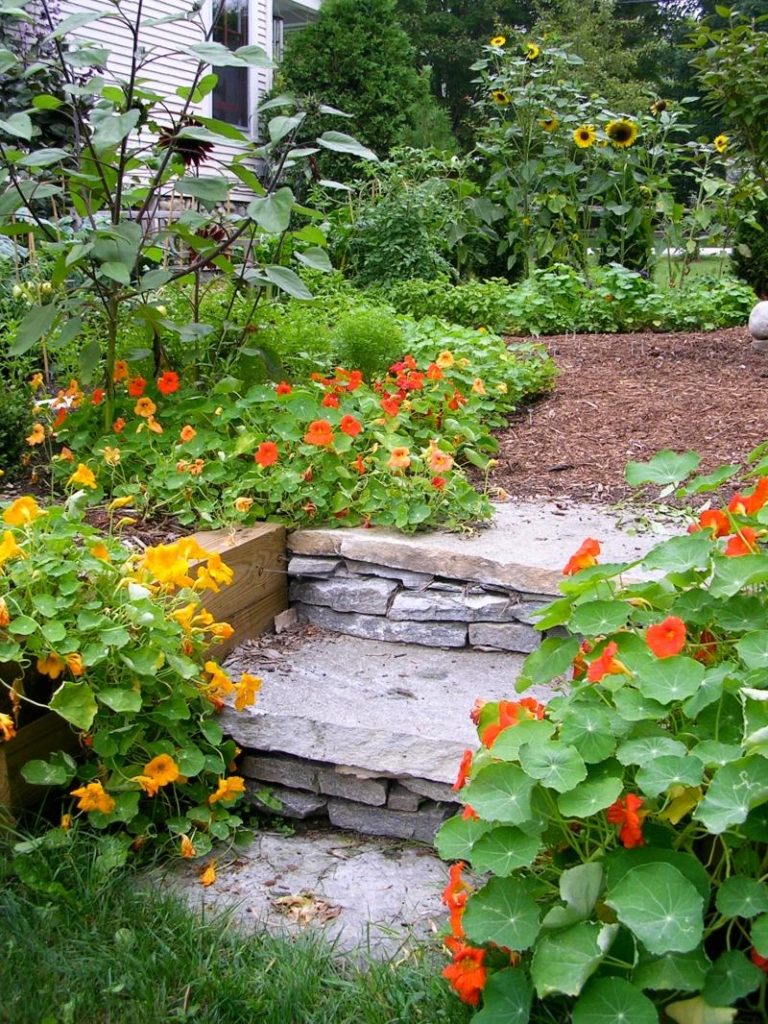 The vegetative method allows you to save species and varietal characteristics during reproduction.
The vegetative method allows you to save species and varietal characteristics during reproduction. Pests and diseases
Nasturtium is not only beautiful, but also very useful. In addition, it somehow inspires fear in Colorado beetles, whiteflies, aphids, cabbage bugs and other insect pests.
But diseases of nasturtium sometimes affect, first of all, such as bacterial wilt , which is expressed in the weakening of the lower leaves, and then withering of the whole plant.
Or gray rot showing dry brown spots on the leaves. From time to time, brown or black rust spots or variegated mosaic stains appear on the leaves of nasturtium. In case of damage by these diseases, infected specimens must be removed and burned, and healthy plants should be treated with special preparations that destroy pathogens.
Pictured: Growing red nasturtium
How to collect seeds
If you feel like breeding, you can collect nasturtium seeds yourself.
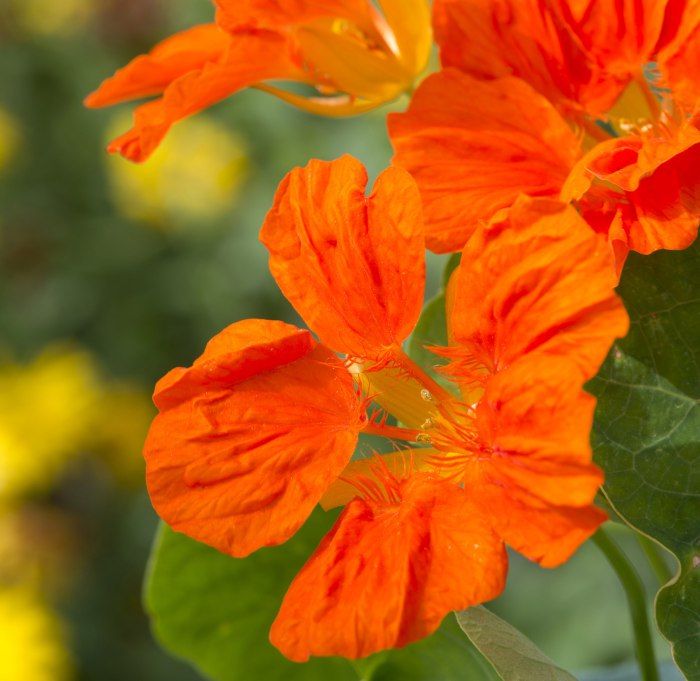 As the flowers wither, the seeds mature. It must be remembered that the seeds of all types of nasturtium have time to ripen before frost, the only exception is foreign nasturtium. When the seeds ripen, they turn from green to whitish and, easily separated from the pedicel, fall to the ground.
As the flowers wither, the seeds mature. It must be remembered that the seeds of all types of nasturtium have time to ripen before frost, the only exception is foreign nasturtium. When the seeds ripen, they turn from green to whitish and, easily separated from the pedicel, fall to the ground. - The main work in the garden at the end of summer - relax early
Therefore, be careful and try to collect them before they crumble.
Store mature seeds in cardboard boxes. Foreign nasturtium seeds are harvested unripe and ripened at home.
In the photo: Large orange flowers of nasturtium
Nasturtium after flowering
After the nasturtium has faded, watering is gradually reduced until it stops completely. Since nasturtium is grown mainly as an annual plant, then with the onset of autumn it is necessary to deal with it as with an annual, namely: dig up the site, burn the tops, after collecting the seeds, if necessary.

Species and varieties
In the wild, at home, perennial nasturtium grows, but in our gardens the tropical beauty cannot remain in the ground for the winter, therefore it is grown as an annual. Of the cultivated species of nasturtium, the following are most often grown:
Foreign nasturtium (Tropaeolum peregrinutn)
Or Canarian nasturtium - a climber from South America, the light green stems of which reach a length of 350 cm and very quickly braid arbors and trellises. It blooms from mid-summer to frost with bright yellow small flowers with corrugated petals and green spurs. The leaves are medium-sized, five- or seven-parted. Seeds in the middle lane do not have time to ripen naturally.
In the photo: Large nasturtium (Tropaeolum majus)
Large nasturtium (Tropaeolum majus)
Very branched, bare, brittle stems reach a length of 250 cm. . Blooms profusely from June to autumn frosts. It reproduces well by self-sowing, the seeds do not lose their germination capacity up to 4 years.
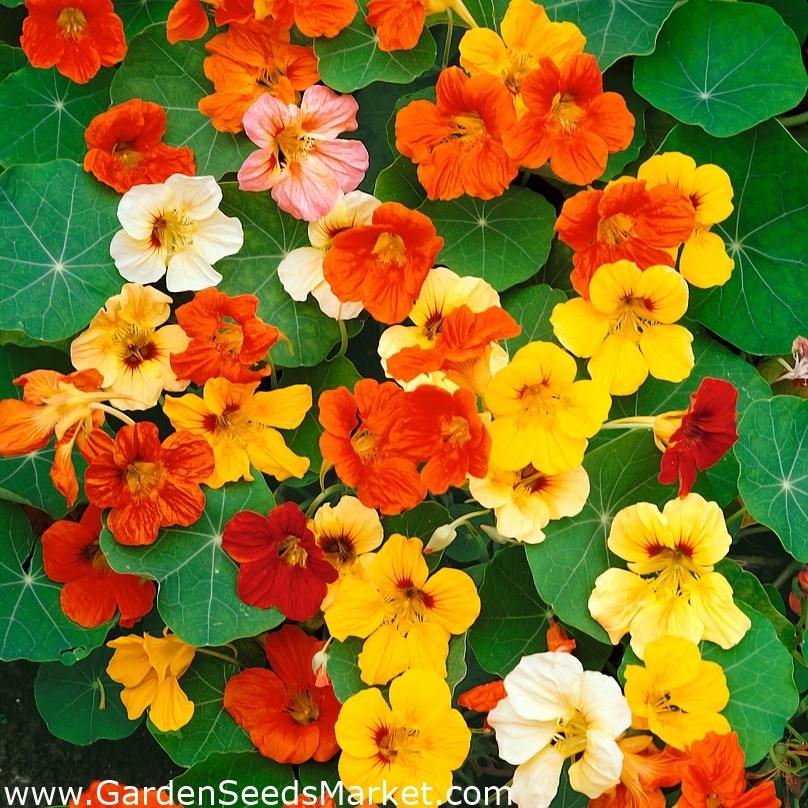 The leaves are asymmetrical, large, round, thyroid, the surface is light green, the underside is gray-gray, the petioles are long, diameter is about 8 cm. The species is represented by dozens of varieties, including compact bush forms:
The leaves are asymmetrical, large, round, thyroid, the surface is light green, the underside is gray-gray, the petioles are long, diameter is about 8 cm. The species is represented by dozens of varieties, including compact bush forms: - King Theodore bright red flowers;
- Peach Melba - cream flowers, red spots in the center;
- Salmon Baby - semi-double flowers, salmon color;
- Ladybug - apricot flowers with burgundy spots in the middle.
Cultivated nasturtium (Tropaeolum cultorum)
Combines hybrids of shield-bearing nasturtium and large nasturtium, densely leafy stems, green or purple leaves, thyroid-like. Varieties of this species differ in shape and height: there are compact varieties of nasturtium (up to 50 cm tall), there are creeping ones, with shoots up to 4 m long, or dwarf ones - 15-20 cm tall. Varieties:
- Gleming Mahagani - shrub up to 37 cm tall with double red flowers;
- Golden Globe - spherical bush up to 25 cm high and 40 cm wide with round light green leaves and large (up to 6.
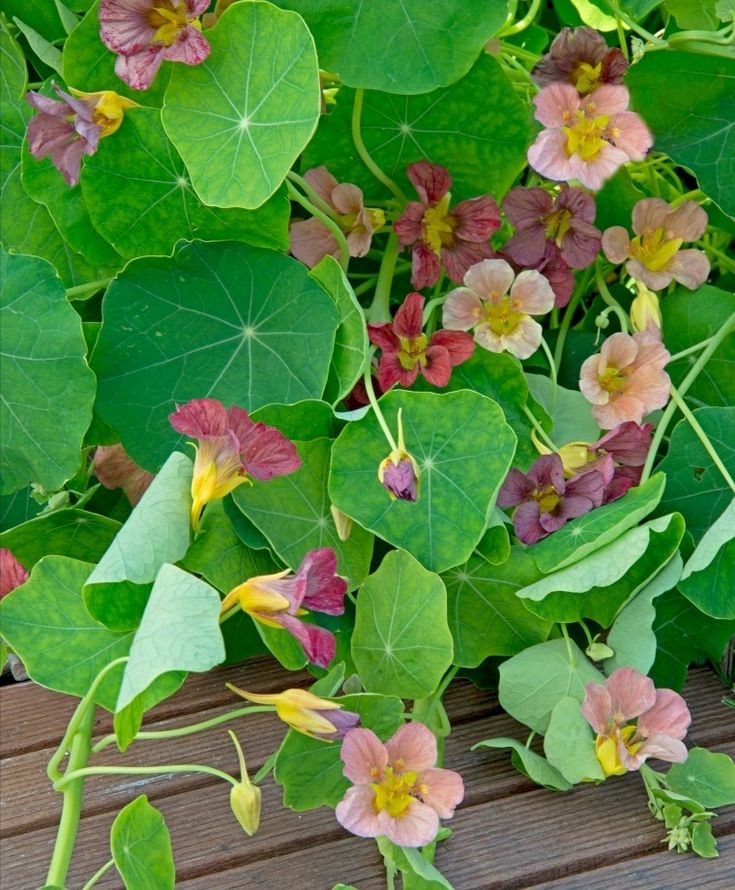 5 cm in diameter) double golden yellow flowers;
5 cm in diameter) double golden yellow flowers; - Moonlight is a climbing plant with stems up to two meters long and pale yellow flowers.
In the photo: Large nasturtium (Tropaeolum majus)
Lesser nasturtium (Tropaeolum minus)
Branched, striated thin stems up to 35 cm tall, nasturtium lesser leaves are rounded, small, shield-like, petioles are very long and thin. Small flowers up to 3 cm in diameter, yellow with dark spots, three upper velvety petals are pointed along the edge, spurs are cylindrical, curved. This type of nasturtium blooms from June to October. Varieties:
- Cherry rose - grows up to 30 cm in height, blooms with bright red double flowers;
- Black Velvet - the same 30 cm in height, simple flowers up to 6 cm in diameter, so dark burgundy that it is almost black. Sometimes this variety is called the Black Lady.
Shield nasturtium (Tropaeolum peltophorum)
It is a creeping shrub with dark green, succulent and brittle shoots up to 4 m in length.
 Leaves are thyroid, dark green. Juicy dark red flowers. It blooms from June to October, the seeds ripen perfectly. Most common variety:
Leaves are thyroid, dark green. Juicy dark red flowers. It blooms from June to October, the seeds ripen perfectly. Most common variety: - Lucifer - upright bushes up to 25 cm tall, light green shoots, large leaves, dark green with a dark red tint. The flowers are simple, up to 6 cm in diameter, red-orange.
In the photo: Lilac nasturtium
Among other types of nasturtium, which are distinguished by their decorative effect, one can name azure, ciliated, multi-leaved, beautiful, tricolor and others, but, unfortunately, few can boast of the experience of growing these species in our climatic zone.
Medicinal properties of nasturtium
Nasturtium is not only beautiful, but also edible and healing. The leaves and flowers of young plants are used as ingredients in salads, garnished with dishes, and added to sandwiches and soups. Pickled nasturtium fruits taste like expensive capers. And dried and ground seeds can be used as a seasoning instead of black pepper, in any case, this was done during the Second World War.
 All parts of the plant are edible except the roots.
All parts of the plant are edible except the roots. In the photo: A beautiful flower of nasturtium
The healing properties of nasturtium have also been known for a long time. It treats skin rashes, stimulates hair growth, it helps with anemia, beriberi, kidney stone disease. The plant has proven itself well as a means of combating scurvy, since the amount of vitamin C in it is ten times greater than in lettuce leaves. In addition, nasturtium contains substances that successfully fight microbes - provitamin A and phytoncides.
Dishes prepared from nasturtium are included in the therapeutic diet for metabolic disorders in the elderly, with atherosclerosis. The rhizomes of tuberous nasturtium species contain substances that lower the level of testosterone in the blood, which is necessary in certain cases. Modern science has established that nasturtium has such valuable properties for medicine: anti-inflammatory, laxative, diuretic, diuretic, antiseptic, antibiotic, antiscorbutic, uroseptic, expectorant.

However, you should be aware that an overdose of nasturtium provokes irritation of the mucosa of the gastrointestinal tract.
Literature
- Read related topics on Wikipedia
- Features and other plants of the Nasturtium family
- List of all species on The Plant List
- More information on World Flora Online
Daffodils: planting outdoors in autumn
Do not feed petunias now - what should be checked before fertilizing?Sections: Garden plants Garden perennials Garden herbaceous plants Garden flowering plants Garden annuals Garden medicinal plants Garden shrubs Garden vines Plants on N Add a comment
outdoor planting and care, growing from seeds
Nasturtium (Tropaeolum), also called capuchin, is a member of the Nasturtium family.
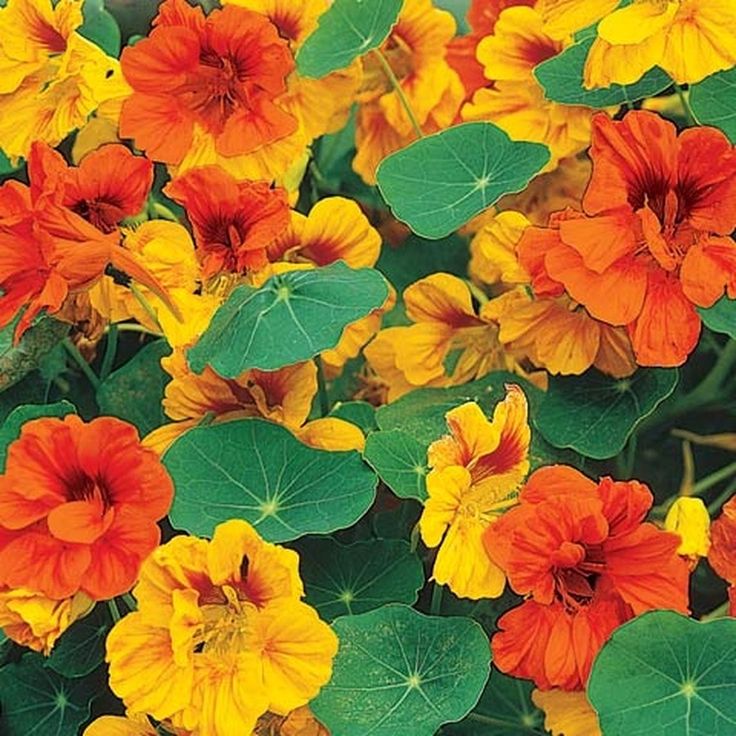 This genus is represented by herbaceous plants, it combines approximately 90 kinds. The birthplace of nasturtium is Central and South America, however, it has been grown in the middle latitudes for a very long time, and it is quite popular. This plant is unpretentious to growing conditions, and it also has popular taste characteristics and medicinal properties. And also during flowering, nasturtium looks extremely impressive, and can become an ornament to any garden plot. This plant was brought to Russia from Holland, and at first they began to call it capuchin there, which is associated with the shape of the flower, which looks like a hood. However, over time, this plant began to be called nasturtium more and more. The scientific Latin name "Tropaeolum" was given to the flower by Carl Linnaeus. 9Ol000
This genus is represented by herbaceous plants, it combines approximately 90 kinds. The birthplace of nasturtium is Central and South America, however, it has been grown in the middle latitudes for a very long time, and it is quite popular. This plant is unpretentious to growing conditions, and it also has popular taste characteristics and medicinal properties. And also during flowering, nasturtium looks extremely impressive, and can become an ornament to any garden plot. This plant was brought to Russia from Holland, and at first they began to call it capuchin there, which is associated with the shape of the flower, which looks like a hood. However, over time, this plant began to be called nasturtium more and more. The scientific Latin name "Tropaeolum" was given to the flower by Carl Linnaeus. 9Ol000 - 4 Caring for nasturtium
- 4.1 Propagating nasturtium
- 4.2 Diseases and pests
- 5 How to harvest nasturtium seeds
- 6 Nasturtium after flowering
- 7 Types and varieties of nasturtium with photos and names
- 7.
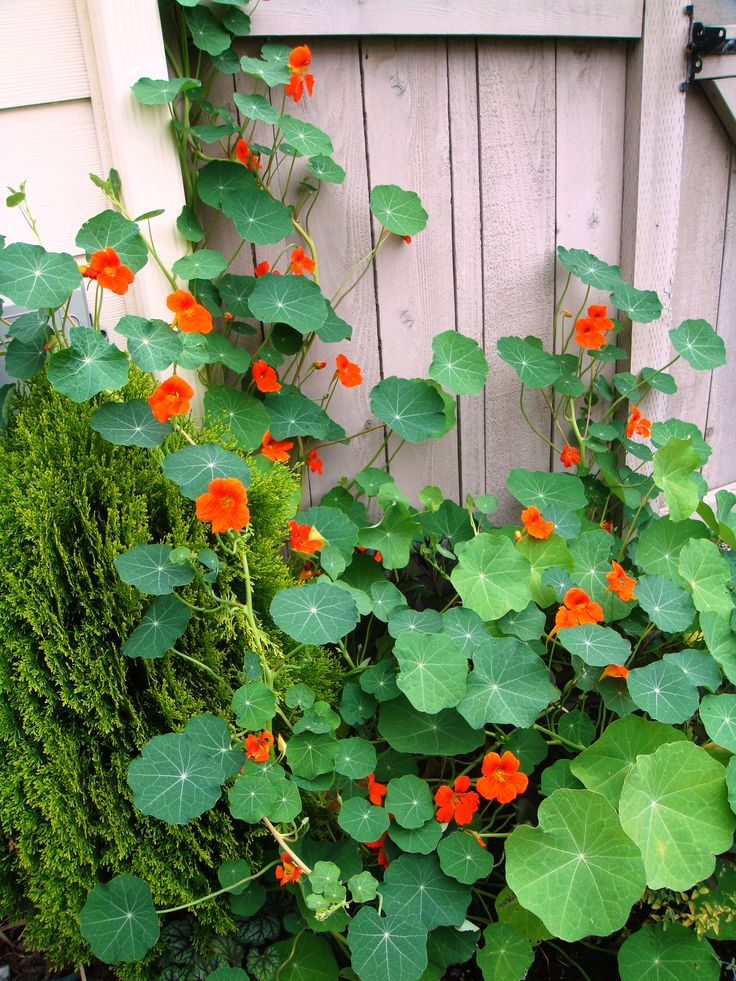 1 Nastemic named after
1 Nastemic named after - 7.2 Nasturge large
- 7.3 Nastement Cultural
- 7.
- 7 properties of nasturtium
Features of nasturtium
Nasturtium is a perennial or annual plant. Often it is a liana with succulent shoots, semi-shrubs are less common. Often the leaf blades are alternately lobed, entire, thyroid or palmately divided. Fragrant flowers can be double, single or semi-double. They are zygamorphic, have an irregular shape, axillary and bisexual. They include 5 petals (in some cases more), the same number of sepals, as well as a funnel-shaped tube, inside which is nectar. The flowers are usually yellow or red. The composition of the fruit includes 3 kidney-shaped wrinkled lobes, and in each of them seeds of a rounded kidney-shaped form ripen.
The shoots and flowers of this plant have medicinal properties, and they are also used in the preparation of various culinary dishes.
Nasturtium is an undemanding plant for gardens and balconies.
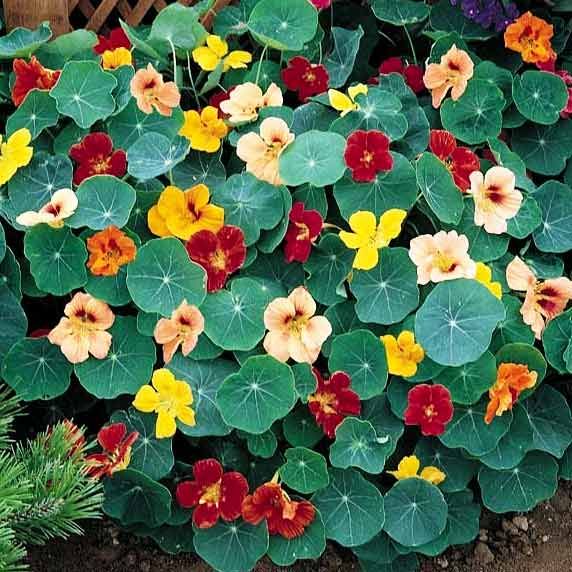 Planting and care for lush flowering
Planting and care for lush flowering
Watch this video on YouTubeGrowing nasturtiums from seeds
Seeding
Nasturtiums are propagated using a generative (seed) method. It is relatively easy to grow such a plant from seeds. Nasturtium seeds are quite large. They are sown directly in open soil in the second half of May, while the return frosts should be left behind. Make shallow (about 20 mm) holes, between which a distance of 0.25–0.3 m should be observed. Seeds are sown in a nested way, while 3 or 4 seeds should be placed in 1 hole. If it is still cold at night, then the area with crops is covered with any covering material (for example, plastic wrap). Watering crops should only be tepid water. The first seedlings will appear after 7-15 days.
Seedling care
You can also grow nasturtium through seedlings, in which case flowering will occur earlier than when sowing seeds in open soil. For sowing, you need to use cups with a retractable bottom or peat.
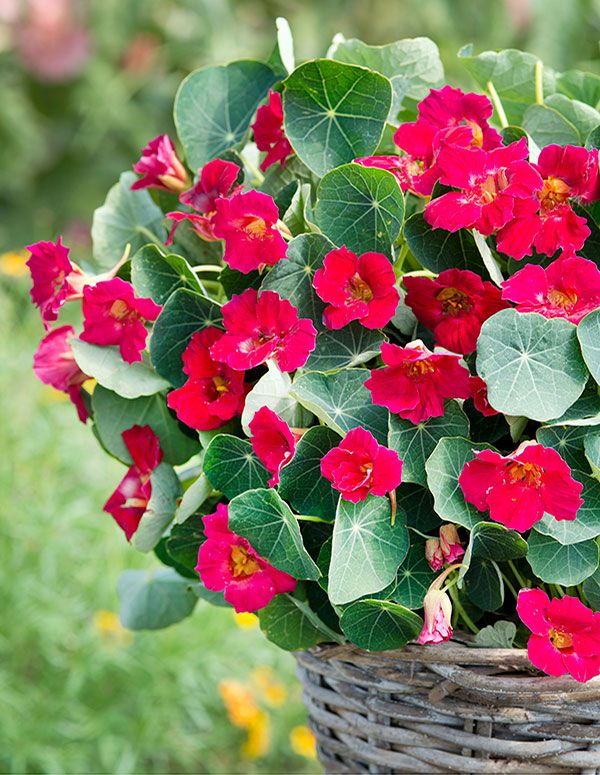 Seeds are sown in April or May, they are buried in the substrate by 20 mm, while 2 or 3 seeds are placed in 1 cup. Then the cups are moved to a cool (from 20 to 22 degrees) place. The first seedlings will appear after about 15 days. The plants that have appeared should be provided with good lighting so that they do not stretch out, otherwise, after transplanting into open ground, they will hurt for a long time and not bloom. Since the root system of nasturtium is rather fragile and weak, and the leaf surface is large, the seedlings are not picked, and the seedlings are planted in open soil right in the cups, without violating the integrity of the earthy coma.
Seeds are sown in April or May, they are buried in the substrate by 20 mm, while 2 or 3 seeds are placed in 1 cup. Then the cups are moved to a cool (from 20 to 22 degrees) place. The first seedlings will appear after about 15 days. The plants that have appeared should be provided with good lighting so that they do not stretch out, otherwise, after transplanting into open ground, they will hurt for a long time and not bloom. Since the root system of nasturtium is rather fragile and weak, and the leaf surface is large, the seedlings are not picked, and the seedlings are planted in open soil right in the cups, without violating the integrity of the earthy coma. Nasturtium: cultivation and care
Watch this video on YouTubePlanting nasturtium in open ground
When to plant
Nasturtium seedlings are planted in open ground in the first decade of June. For landing, you need to choose a sunny area that has reliable protection from cold winds.
 If this flower culture is grown in a shaded place, then its flowering will not be so lush and spectacular. The soil needs a light, nutritious, slightly acidic, and also well-drained. If there is too much organic matter in the soil, then the greenery of the bushes will grow very intensively, but they will not bloom. When growing nasturtium on excessively depleted soil, its leaf plates become small, which is why the shoots look bare, and flowering loses its high decorative effect. If you choose stagnant, moist soil for planting, the plant will rot.
If this flower culture is grown in a shaded place, then its flowering will not be so lush and spectacular. The soil needs a light, nutritious, slightly acidic, and also well-drained. If there is too much organic matter in the soil, then the greenery of the bushes will grow very intensively, but they will not bloom. When growing nasturtium on excessively depleted soil, its leaf plates become small, which is why the shoots look bare, and flowering loses its high decorative effect. If you choose stagnant, moist soil for planting, the plant will rot. Planting features
As mentioned above, seedlings are planted in open soil in the first days of June. The seedlings are planted together with peat cups or with a clod of earth, and you should be extremely careful, because the root system of the seedling can be easily injured. The distance between the plants directly depends on their variety and type, and it can vary from 0.2 to 0.4 m. At first, the planted plants will need to be covered for the night.
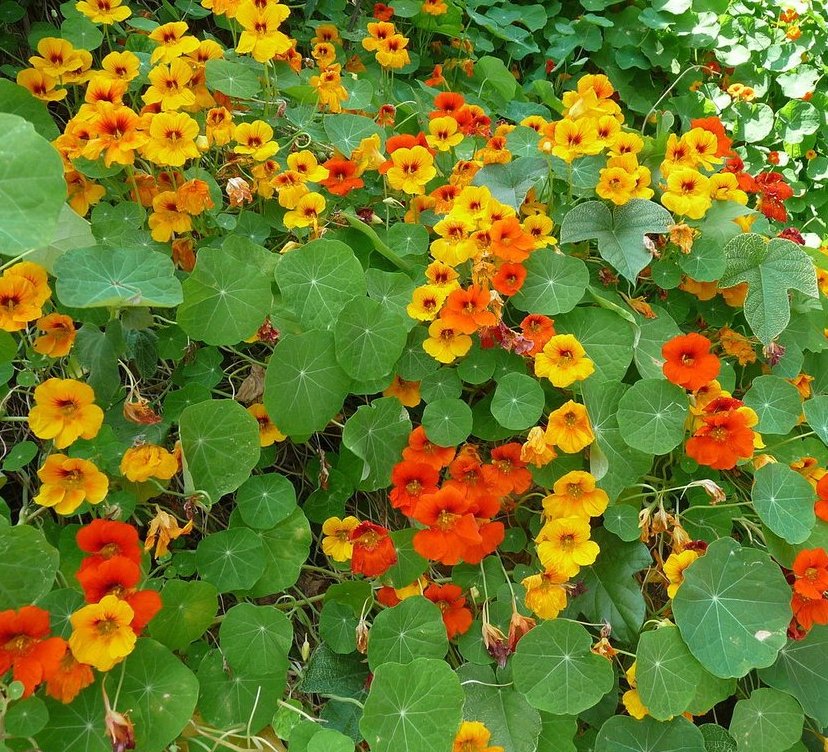 Flowering will begin after 4-6 weeks.
Flowering will begin after 4-6 weeks. Caring for nasturtiums
Caring for nasturtiums is very easy. They need to be watered and weeded in a timely manner. If, after the seedlings were planted on the site, you covered its surface with a layer of mulch, then this will avoid a grueling fight against weeds. At the very beginning of active growth, special attention should be paid to systematic watering, which should be plentiful. After flowering begins, watering should be arranged only when the soil dries out, but if it is constantly moistened, this will negatively affect the flowering splendor, but greenery will grow violently. It is also very important to cut off the flowers that have begun to fade in time. If you want to collect seeds, then leave only a few ovaries for this.
Before flowering, this plant is regularly fertilized with phosphorus-potassium fertilizer with a frequency of 1 time in 7 days. This crop is not fed with nitrogen-containing fertilizers.
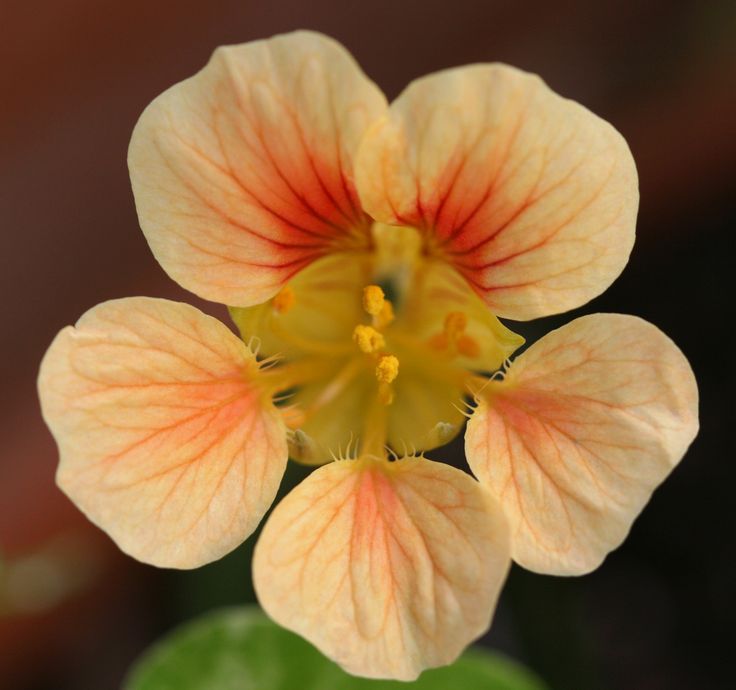
Propagation of nasturtium
See above for how to grow nasturtium from seed. They also use cuttings for propagation. For rooting cuttings, well-moistened sand or water is used. This method of propagation is usually used for terry varieties or for very rare ones, the seeds of which are difficult to buy. When propagated by cuttings, all varietal and species characteristics of the mother plant are completely preserved.
Diseases and pests
This plant is very beautiful and incredibly useful. In addition, it repels whiteflies, cabbage, Colorado potato beetles, aphids and other pests.
However, nasturtium can still get sick. For example, it is affected by bacterial wilt. In the affected specimen, the lower leaf plates first weaken, and then the entire bush begins to fade. And it can also get sick with gray rot, due to which dry spots of brown color form on the leaf plates. Also on the surface of the foliage you can sometimes see variegated mosaic stains or black or brown spots of rust.
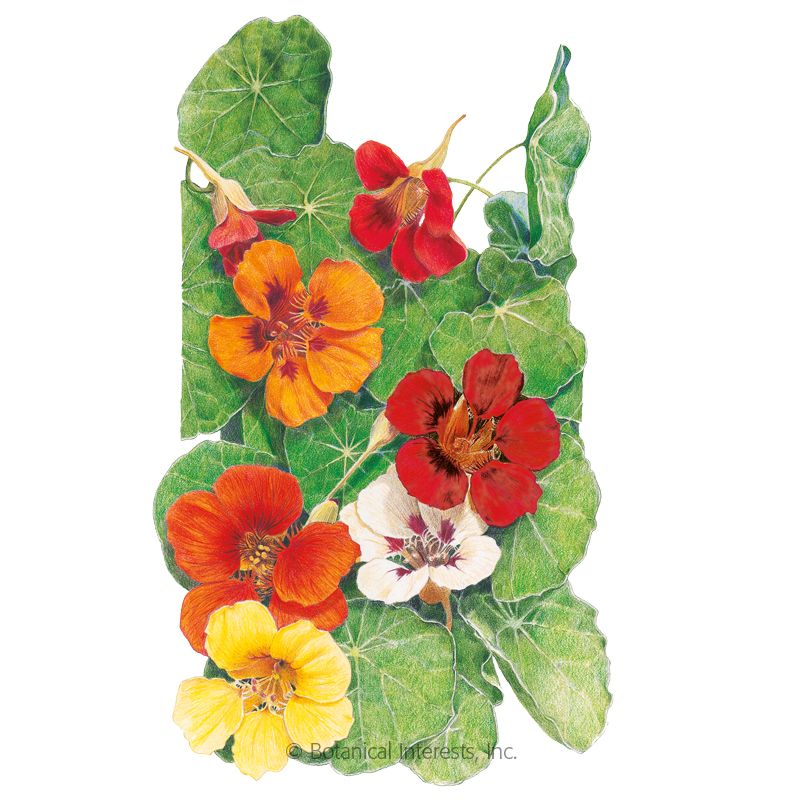 If symptoms of these diseases occur, the affected bushes must be dug up and destroyed. At the same time, the remaining healthy flowers are sprayed with a special agent that can destroy pathogens.
If symptoms of these diseases occur, the affected bushes must be dug up and destroyed. At the same time, the remaining healthy flowers are sprayed with a special agent that can destroy pathogens. Unpretentious flowers for the garden Nasturtium. Garden World
Watch this video on YouTubeHow to collect nasturtium seeds
If you want to feel like a breeder, then you will need to collect nasturtium seeds from your site. Seed ripening is observed at the same time that flower wilt occurs. Only foreign nasturtium seeds do not have time to ripen before frost, and this must be taken into account. Ripe seeds change their green color to whitish, they are easily separated from the pedicel and fall to the surface of the site. In this regard, it is not necessary to delay the collection of seeds, because they can crumble. For storage, the seeds are placed in cardboard boxes. The collected immature seeds of foreign nasturtium should be ripened at room conditions.
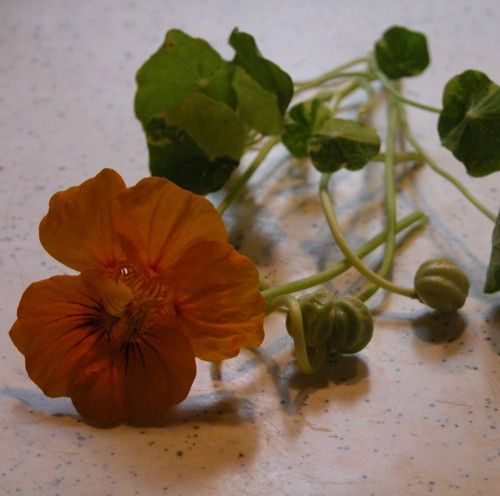
Nasturtium after flowering
When flowering ends, the bushes should be watered less and less each time until they stop completely. In mid-latitudes, as a rule, this plant is cultivated as an annual, therefore, in autumn, it should be treated as an annual. More precisely, clear the area of plant debris that must be destroyed. The site itself should be dug up. Don't forget to collect seeds first if needed.
Types and varieties of nasturtium with photos and names
Naturally growing nasturtium is a perennial plant. However, in mid-latitude gardens, this flower can only be grown as an annual, because it is not able to survive the winter in the open field. The most popular among gardeners are cultivated types of nasturtium, which will be described below.
Nasturtium foreign, or Canarian
This creeper is native to South America. The length of greenish shoots can reach 3.5 m, while they relatively quickly braid trellises and arbors.
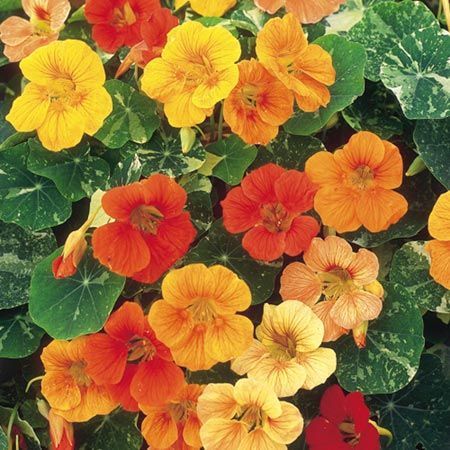 Flowering begins in the middle of the summer period, and ends with the onset of frost. Small flowers of rich yellow color have corrugated petals, as well as green spurs. Small leaf plates can be five- or seven-parted. In middle latitudes, the seeds do not have time to ripen.
Flowering begins in the middle of the summer period, and ends with the onset of frost. Small flowers of rich yellow color have corrugated petals, as well as green spurs. Small leaf plates can be five- or seven-parted. In middle latitudes, the seeds do not have time to ripen. Large nasturtium
Fragile bare shoots are strongly branched, they can be about 2.5 m long. There are not creeping, but erect varieties, in this case the height of the shoots can reach 0.7 m. and ends with the onset of frost in the fall. This species reproduces well by self-seeding. Seeds remain viable for 4 years. Large asymmetrical leaf blades are rounded and shield-shaped. Their front surface is greenish, and the wrong side is gray-gray. They have long petioles, and the leaves are 80 mm across. This species has many varieties, among which there are also compact bush forms, for example:
- King Theodore - rich red flowers;
- Peach Melba - there are red spots in the center of creamy flowers;
- Salmon Baby - semi-double flowers have a salmon color;
- Ladybug - there are burgundy spots in the middle of the apricot flower.

Cultural nasturtium
This species combined hybrids of large nasturtium and shield-bearing nasturtium. Shoots are densely leafy. Thyroid leaf plates have a purple or green color. In this species, varieties differ in height and shape:
- compact varieties up to half a meter high;
- creeping varieties with stems up to 4 meters long;
- dwarf varieties that do not exceed 15–20 centimeters in height.
Varieties:
- Gleming Mahagani - bush height about 37 centimeters, double red flowers;
- Golden Globe - a spherical bush reaches a height of 0.25 m, and a width of 0.4 m, leaf plates are round greenish, double large (about 65 mm in diameter) flowers are painted in yellow-golden color;
- Moonlight - the length of the shoots of this climbing plant is about 2 m, the color of the flowers is yellowish.
Small nasturtium
Thin branched furrowed shoots are about 0.
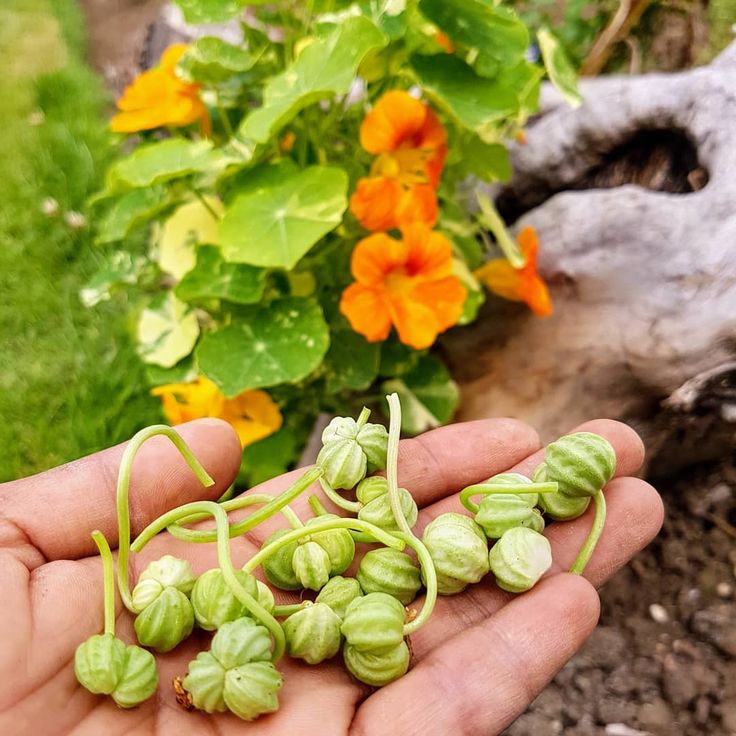 35 m high. Small shield-like leaf blades are rounded, petioles are thin and very long. Yellow small flowers in diameter reach 30 mm, there are dark spots on the surface, 3 upper petals are velvety and have a pointed edge, curved spurs are cylindrical in shape. Flowering is observed in June-October. Varieties:
35 m high. Small shield-like leaf blades are rounded, petioles are thin and very long. Yellow small flowers in diameter reach 30 mm, there are dark spots on the surface, 3 upper petals are velvety and have a pointed edge, curved spurs are cylindrical in shape. Flowering is observed in June-October. Varieties: - Cherry rose - bush height about 0.3 m, double flowers have a rich red color;
- Black velvet - a bush reaches a height of 0.3 m, the color of simple flowers is maroon almost black, they reach 60 mm in diameter, this variety is sometimes called "Black Lady".
Shield-bearing nasturtium
This species is represented by creeping shrubs. Fragile juicy stems are painted in dark green color, they reach 4 meters in length. Thyroid leaf plates have a dark green color. The color of the flowers is deep dark red. Flowering is observed in June-October, the seeds have time to ripen. The most popular variety is Lucifer: the height of erect bushes is about 0.
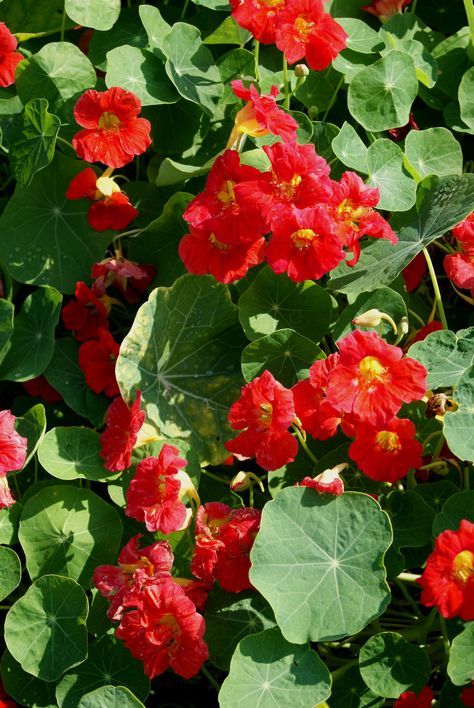 25 m, the color of the stems is greenish, large leaf plates of dark green color have a dark red tint. Simple orange-red flowers in diameter reach 60 mm.
25 m, the color of the stems is greenish, large leaf plates of dark green color have a dark red tint. Simple orange-red flowers in diameter reach 60 mm. Also decorative types of nasturtium are azure, ciliate, many-leaved, beautiful, tricolor, but they are grown extremely rarely in the middle latitudes.
Useful properties of nasturtium
Very beautiful nasturtium flower has medicinal properties and can also be eaten. Flowers and foliage of young plants are added to soups, salads and sandwiches, and various dishes are also decorated with them. Pickled fruits of such a flower taste similar to expensive capers. If the seeds are well dried and ground, you will get a spicy seasoning that can be used instead of black pepper. By the way, this seasoning was widely used during the Second World War. You can eat all parts of this culture, but not the roots.
The healing properties of nasturtium have been known for a long time. It is used to stimulate hair growth, in the treatment of skin rashes, as well as beriberi, anemia and nephrolithiasis.
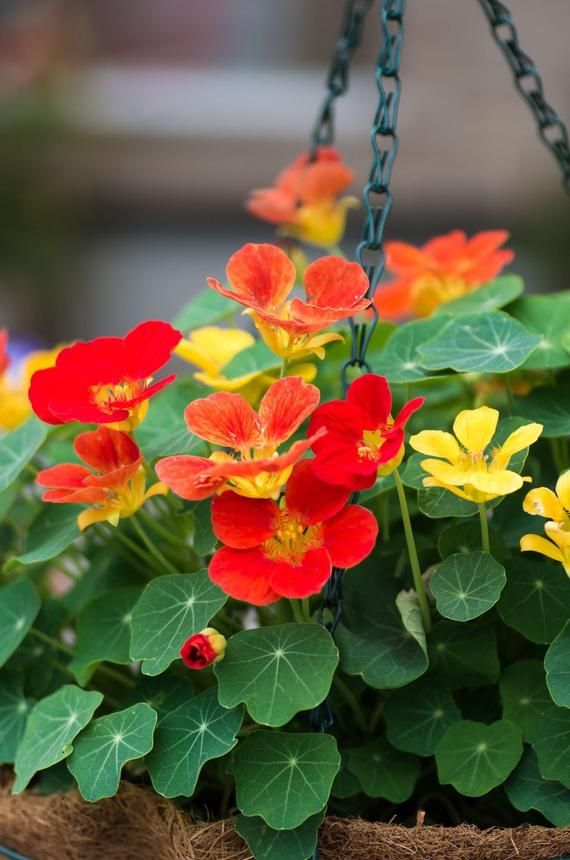
- Semlos0002 Why is nasturtium so good? She is beautiful, useful, completely unpretentious to the conditions and does not require special care.





